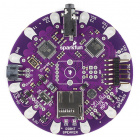TheSpaceCadet
Member Since: January 12, 2011
Country: United States
-
Hola! Why are there no examples for changing profiles on the fly? I tried simply changing the argument in pd.setPdoNumber() but no voltage change on the output. I also tried changing the individual PDO voltages to no avail. Any hopes of an example or a pro tip?
-
Hola! Why are there no examples for changing profiles on the fly? I tried simply changing the argument in pd.setPdoNumber() but no voltage change on the output. I also tried changing the individual PDO voltages to no avail. Any hopes of an example or a pro tip?
-
Just a resurrection comment in case anyone is still around... If you were to incorporate hardware capable of intentional radiation into a dev platform but not include its use in the firmware that ships with the device, are you still responsible for intentional radiator testing? Does it depend on what you market the device as? i.e. if you market it as Wi-Fi capable, then you'd have to get it tested for intentional radiator and otherwise not? I'm asking specifically for a product incorporating an ESP32 or ESP8266, but in the OSH world, we see lots of transmission-capable products that ship with a blank slate on the software side for the end user to utilize. It seems to fit the spirit of the FCC rules that the device I'm describing would need certified under part C for intentional ONLY if it is marketed as having Wi-Fi/Bluetooth capability OR it has an on-board antenna or other RF-specific hardware (like a Pi network with an antenna connector).
I guess the question is: In the OSH-world of entirely user-defined software, does the manufacturer have to test/certify for all reasonable use-cases that its hardware supports?
I haven't been able to find this line of questioning serviced elsewhere, and thought it might be appropriate to pose the question here.
-
What is the advantage of something like this over some MOSFETs with pull-up resistors to handle logic level translation???
-
Nice price point. I'm saturated on the arduino side of the house, but it's good to see you guys constantly innovating. Question: when you set the board to 3.3V, I'm curious if that has effect on the 328 since you'll be running 16MHz at 3.3V. Any Xperimentation behind that added hackability feature? Also, why not just throw a DC-DC regulator with dual outputs on this bad boy and give the user some real power? Is the price point holding you back? Also, why not break out A6 and A7 if you're going for versatility (you could use one with a v-divider to read the input voltage on the DC barrel jack or something clever)? If this rolls out of X, but some sexy silk art on the bottom, like a giant flame (unless that makes the boards more expensive). Adafruit products would suggest that you should step the style game up just a tad. I've got a lot of ideas. - Tyler
-
Since there's no reset pin on the quiic, I'm having trouble using the libraries in the particle environment. For the cube example, the cube showed up, but never moved. The other example doesn't work at all. Do you have any pointers?
-
SFE,
For these motors, can we PLEASE get some sort of datasheet for each model, or at least a power and torque curve. That kind of information is important! These parts are too expensive to employ the guess and check method when you're designing for complex systems!
-Tyler
-
I think aeroguy was mistaken. I'm pretty sure this chip acts as a power source. Putting them in parallel wont do anything to the voltage, but it should give you double the power. If each could output 150mA at 5V if Vin is 3V (let's pretend), then two of them in parallel could provide 300mA total. If current doubles, power doubles (assuming constant voltage).
-
I would like to attempt to modify the Army standard issue watch cap. With winter coming up, being stationed at the National Training Center means 14 day rotations in the training area with no heat, A/C power, or other creature comforts. What's worse is that while a Soldier is trying to relax in his HMMWV or Tracked vehicle, it's not always acceptable to jam out to some tunes to pass the long days sitting in assembly areas and on observation posts. I want to try to use this; in conjunction with a LiPo battery, small speakers, and a few buttons; to embed an Mp3 player inside of the standard issue watch cap. I'd like to see how it stands up to the brutal conditions of 'the Box.'
-
"Hey guys, I have this crazy idea: let's take the light bulbs and make the conference room even brighter!"
No public wish lists :(









